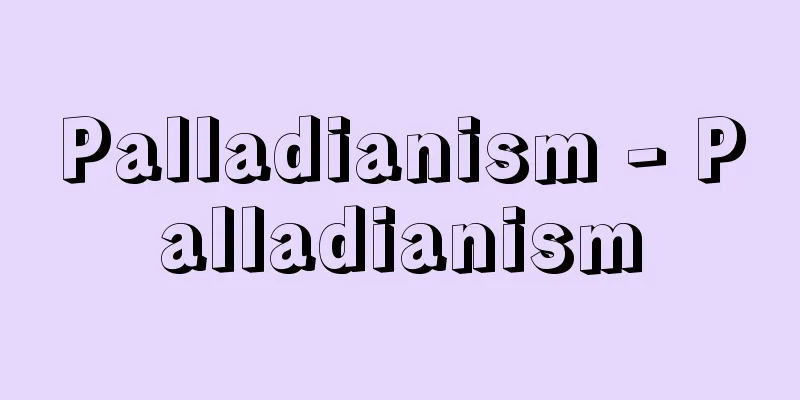Avogadro's law

|
One of the laws of gases. It states that "at the same temperature and pressure, all gases contain the same number of molecules in the same volume." It is an extremely important law that clarified the distinction between atoms and molecules, provided a method for determining molecular weight, and became the basis for the establishment of modern chemistry. It was proposed by the Italian Avogadro in 1811, but since the existence of the central molecule was not proven, it was generally ignored and called "Avogadro's hypothesis." However, after the existence of molecules was revealed and the Avogadro constant was actually determined, providing a factual basis, and it came to be called "Avogadro's law." In other words, all gases are made up of tiny particles called molecules, and for example, at standard conditions (0°C, 1 atm), any gas will have about 6 x 10 23 molecules (the Avogadro constant) in the same volume (22.4 liters). [Nakahara Katsunori] How Avogadro's law came into existenceBefore Avogadro, the idea that "all gases are made up of atoms, which are ultimate particles," as asserted by Dalton and Berzelius, was believed. In other words, Dalton believed that "simple substances are made up of one type of atom, and compounds are made up of one type of composite atom (corresponding to today's molecules) formed by the gathering of these atoms," and studied the quantitative relationships of the component elements (establishing the basis of the concept of atomic weight). For example, he believed that oxygen contains oxygen atoms, hydrogen contains hydrogen atoms, and water contains a composite atom of water formed by the combination of one oxygen atom and one hydrogen atom ( A). This is useful for explaining, for example, that "9 grams of water are produced when 1 gram of hydrogen reacts with 8 grams of oxygen," and if the weight of one hydrogen atom is 1, then the weight of one oxygen atom is 8, and the weight of one water atom is 9. Furthermore, this idea makes it easy to explain things like the "law of multiple proportions." However, there are also major contradictions, and it was not possible to explain various facts that were known up to that time, such as the "law of gas reactions." Dalton et al.'s theory cannot explain the volume ratio of 2:1:2 when hydrogen gas and oxygen gas combine to become water vapor. This is where Avogadro came in and he focused on the volume relationship at this time. In other words, all gases have almost the same thermal expansion coefficient, and when the temperature rises by 1°C, they expand by 1/273 of their original volume (Gay-Lussac's law, also known as Charles' law). In terms of atomic theory, this means that the distance between atoms increases with temperature. First, he stated that (1) "regardless of the type of gaseous substance, the same volume at the same temperature and pressure contains the same number of molecules." Then, to explain the "laws of gas reactions," he stated that (2) "molecules are made up of several atoms, and a single gas is made up of two atoms." These two are Avogadro's hypotheses. This allowed him to explain the reaction between hydrogen and oxygen ( B). However, this important idea was not accepted because the existence of molecules had not yet been proven, and it was not until Cannizzaro's introduction in 1860 that it was re-evaluated. [Nakahara Katsunori] "Atoms and Nuclei" by Iwao Ogawa (1990, Kyoritsu Shuppan)" ▽ "What are Physical Constants? The Mysteries of Universal Numbers that Govern Nature" by Toshimi Saijo (Kodansha, Bluebacks)" ▽ "The Seven Basic Laws of Chemistry" by Takahito Takeuchi (Iwanami Junior New Books)" [References] | | | | | | | | |©Shogakukan "> Avogadro's Law (Figures A and B) Source: Shogakukan Encyclopedia Nipponica About Encyclopedia Nipponica Information | Legend |
|
気体に関する法則の一つ。「同温、同圧のもとでは、すべての気体は同体積中に同数の分子を含む」という法則。原子と分子の区別を明らかにし、分子量決定の方法を与え、近代化学成立の基礎となった、きわめて重要な法則である。1811年イタリアのアボガドロによって提出されたが、中心となる分子の存在が証明されていなかったため、一般にはほとんど無視され「アボガドロの仮説」とよばれた。しかしその後、分子の実在が明らかにされ、実際にアボガドロ定数が決定されて、事実の根拠が得られたことになり、「アボガドロの法則」とよばれるようになった。すなわち、すべての気体は分子とよばれる微小粒子よりなり、たとえば標準状態(0℃、1気圧)では、どのような気体でも同体積(22.4リットル)中に約6×1023(アボガドロ定数)個の分子が存在する。 [中原勝儼] アボガドロの法則が成立するまでアボガドロ以前、ドルトンやベルツェリウスが主張した「すべての気体は極限粒子である原子からなる」という考え方が信じられていた。すなわち、ドルトンは「単体は1種類の原子からなり、化合物はそれらの原子が集まってできた1種類の複合原子(いまの分子に相当する)からなる」として、その成分元素の量的関係について研究した(原子量の考え方の基礎をつくった)。たとえば、酸素には酸素の原子があり、水素には水素の原子があって、また水は酸素1原子と水素1原子とが結び付いてできた水の複合原子があると考えた(A)。このことは、たとえば「水素1グラムと酸素8グラムとが反応して水9グラムができる」ということを説明するのには便利であり、水素1原子の重量を1とすれば、酸素1原子の重量は8、水1原子の重量は9ということである。さらにこの考え方によって、「倍数比例の法則」なども簡単に説明できる。しかし、大きな矛盾もあり、そのころまでに知られていたいろいろな事実、たとえば「気体反応の法則」などが説明できなかった。水素ガスと酸素ガスが化合して水蒸気になるときの体積比が2:1:2になるということは、ドルトンらの考え方では説明できない。 ここに登場したのがアボガドロで、彼はこのときの容積関係に注目した。すなわち、すべての気体は、ほとんど同じ熱膨張係数をもっていて、1℃あがれば、もとの容積の273分の1ずつ膨張するが(ゲイ・リュサックの法則。シャルルの法則ともいう)、このことは原子論からいえば、原子間の距離が温度とともに大きくなることだと考えられる。そこでまず、(1)「気体物質はその種類がどのようなものであっても、同温、同圧の同体積中には同数の分子を含む」とした。そして、「気体反応の法則」を説明するために、(2)「分子はいくつかの原子からなるもので、単体の気体では2個の原子よりなる」とした。この二つがアボガドロの仮説である。これによって水素と酸素の反応が説明できるようになった(B)。しかしこの重要な考え方は、まだ分子の存在が証明されていなかったため認められず、あらためて評価されるのは、1860年カニッツァーロの紹介まで待たなければならなかった。 [中原勝儼] 『小川岩雄著『原子と原子核』(1990・共立出版)』▽『西条敏美著『物理定数とは何か――自然を支配する普遍数のふしぎ』(講談社・ブルーバックス)』▽『竹内敬人著『化学の基本7法則』(岩波ジュニア新書)』 [参照項目] | | | | | | | | |©Shogakukan"> アボガドロの法則〔図A、図B〕 出典 小学館 日本大百科全書(ニッポニカ)日本大百科全書(ニッポニカ)について 情報 | 凡例 |
<<: Apocrine gland - Apocrine gland
>>: Avogadro's Number - Avogadro's Number
Recommend
Bautzen (English spelling)
A city in the state of Saxony in eastern Germany. ...
Iinuma Yokusai
Year of death: June 27, 1865 (Keio 1, leap year 5,...
limping marriage
…There are also cases of bigamy arising in the co...
Asahiza era - Asahiza era
In 1900, Kitamura and Akizuki were the central fi...
Walking net - Kachishikiami
...There is no direct evidence to prove the exist...
False Oogibasho - False Oogibasho
...Flower stalks grow from between the leaf sheat...
Rubia akane (akane) - Akane (English spelling)
A perennial plant of the Rubiaceae family, it is w...
Emanuel‐Eugène Mermet (de) Cachon
1828-70? French missionary. His real name was Merm...
Tarbell, IM
…They often published in popular magazines such a...
Lipps, Theodor
Born: July 28, 1851 Walhalben Died October 17, 191...
Edmont, E. (English notation) EdmontE
...It began with G. Wenker (1852-1911) of Germany...
gṛhamedha (English spelling) grhamedha
…Household rituals were very important, and by th...
Participant observation
…He also deepened his exchanges with social scien...
Kokon Yakusha Rongo Sakigake - Kokon Yakusha Rongo Sakigake
A collection of Kabuki actors' reputations and...
Oil Field - Boiled
The name of the area where crude oil is extracted...









